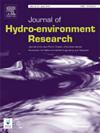Design of optimal environmental flow regime at downstream of reservoirs using wetted perimeter-optimization method
Abstract
Conflict between water demand and environmental flow requirements is a challenging aspect in the reservoir management. Hence, optimizing environmental flow regime is one of the most important tasks at downstream of the large dams. The present study proposes a coupled simulation–optimization method based on the wetted perimeter method as an assessment method of the environmental flow and optimization of the reservoir operation to minimize difference between habitat loss and water demand loss using different metaheuristic algorithms. Moreover, the fuzzy TOPSIS as the decision-making system was applied for ranking the optimization algorithms. Indices including reliability index, vulnerability index, root mean square error and mean absolute error were utilized as criteria to measure the system performance and to select the best algorithm. Based on the results, gravity search algorithm (GSA) was the best method to optimize environmental flow regime at downstream of the reservoir in the case study. The proposed method is able to optimize environmental flow to minimize conflicts between human’s needs and aquatic’s needs considering storage constraints in the reservoir management. The proposed method might minimize negotiations between environmental managers and stakeholders. Furthermore, it should be noted that original wetted perimeter method is not able to provide optimal environmental flow regime based on a balance between users and constraints in the reservoir management such as storage constraints. The proposed method converts wetted perimeter method from an assessment method to a simulation–optimization method for optimizing environmental flow at downstream of the reservoirs.

 求助内容:
求助内容: 应助结果提醒方式:
应助结果提醒方式:


